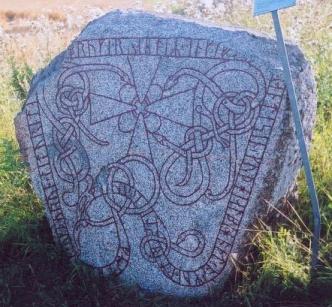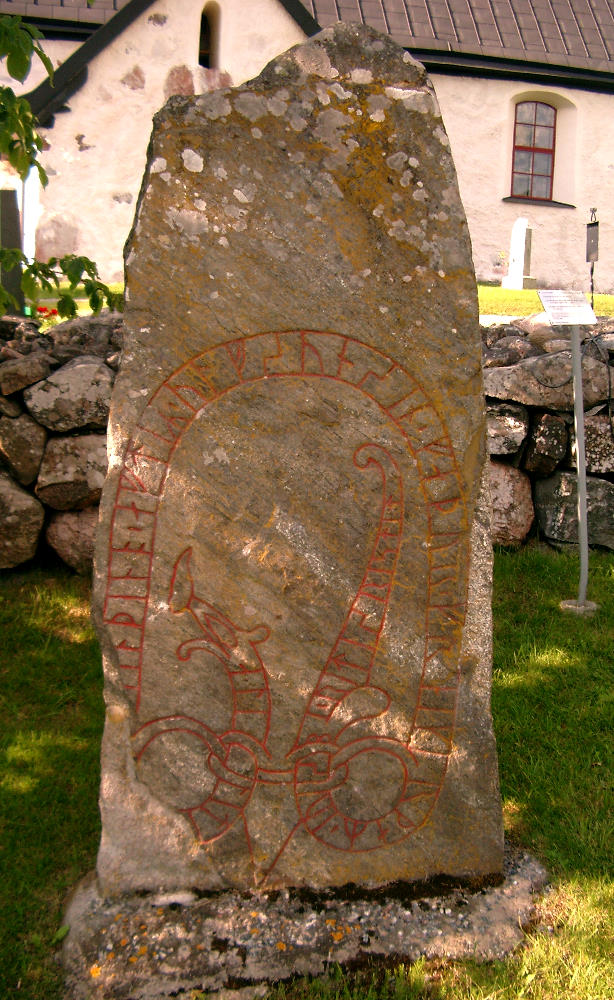|
Runemaster
A runemaster or runecarver is a specialist in making runestones. Description More than 100 names of runemasters are known from Viking Age Sweden with most of them from 11th-century eastern Svealand.The article ''Runristare'' in ''Nationalencyklopedin'' (1995). Many anonymous runestones have more or less securely been attributed to these runemasters. During the 11th century, when most runestones were raised, there were a few professional runemasters. They and their apprentices were contracted to make runestones and when the work was finished, they sometimes signed the stone with the name of the runemaster. Many of the uncovered runic inscriptions have likely been completed by non-professional runecarvers for the practical purposes of burial rites or record-keeping. Due to the depictions of daily life, many of the nonprofessional runecarvers could have been anything from pirates to soldiers, merchants, or farmers. The layout of Scandinavian towns provided centers where craftspeople ... [...More Info...] [...Related Items...] OR: [Wikipedia] [Google] [Baidu] |
Ăpir
Ăpir or ''Ăper'' (Old Norse: ''ĂpiÊ''/''Ćpir'', meaning "shouter") was a runemaster who flourished during the late 11th century and early 12th century in Uppland, Sweden.The article ''Ăpir'' in ''Nationalencyklopedin'' (1996). He was the most productive of all the old runemasters''Runristaren Ăpir begĂ„vad konstnĂ€r'', an announcement on the new dissertation by Marit Ă hlĂ©n at Uppsala University. retrieved January 14, 2007. and his art is classified as being in the highly refined . p. 197. Work During the 11th century, when most runeston ...[...More Info...] [...Related Items...] OR: [Wikipedia] [Google] [Baidu] |
Gunnborga
Gunnborga (fl. 11th century), also known as ''Gunnborga den goda'' (literary: 'Gunnborga the Good'), was a Viking Age Swedish runemaster A runemaster or runecarver is a specialist in making runestones. Description More than 100 names of runemasters are known from Viking Age Sweden with most of them from 11th-century eastern Svealand.The article ''Runristare'' in ''Nationalencyklo .... She was responsible for the HĂ€lsingland Rune Inscription 21, and has been referred to as the only confirmed female runemaster. See also * FrögĂ€rd i Ăsby Notes {{Historic Swedish women artists 11th-century Swedish people Runemasters 11th-century Swedish women Medieval women artists 11th-century artists ... [...More Info...] [...Related Items...] OR: [Wikipedia] [Google] [Baidu] |
Balle (runemaster)
Balle (Old Norse: ''BalliÊ'') or Red-Balle (Old Norse: ''RauĂ°balliÊ'') was a runemaster who was active in the areas of western Uppland, VĂ€stmanland, and northern Södermanland of Sweden during the second half of the 11th century. Work Most early medieval Scandinavians were probably literate in runes, and most people probably carved messages on pieces of bone and wood.Vilka kunde rista runor?'' on the Swedish National Heritage Board website, retrieved January 13 2007. However, it was difficult to make runestones, and in order to master it one also needed to be a stonemason. During the 11th century, when most runestones were raised, there were a few professional runemasters. Balle was active in the later 11th century and his work is representative of the Urnes style, Urnes runestone style. p. 197. Balle signed about twenty-four surviving runestones in south-western Uppland and northern Södermanland. He often signed his name in the form of Old Norse poetry as exemplified on runes ... [...More Info...] [...Related Items...] OR: [Wikipedia] [Google] [Baidu] |
Ă
smund KĂ„resson
Ă smund KĂ„resson was a Viking Age runemaster who flourished during the first half of the 11th century in Uppland and GĂ€strikland, Sweden. The early Urnes style is represented in his art. pp. 197, 208â09. Work Most early medieval Scandinavians were probably literate in runes, and most people probably carved messages on pieces of bone and wood.Vilka kunde rista runor?' on the Swedish National Heritage Board website, retrieved January 13, 2007. However, it was difficult to make runestones, and in order to master it one also needed to be a stonemason. During the 11th century, when most runestones were raised, there were a few professional runemasters. Ă smund was active mainly in Uppland, and about twenty runestones are signed by him and an additional thirty stones have been attributed to him. The ornamentation is characterized by variation with firmness and security in the composition. Ă smund is the inventor of the classic Uppland runestone style with one or two animals (''rundju ... [...More Info...] [...Related Items...] OR: [Wikipedia] [Google] [Baidu] |
VisÀte
VisĂ€te (Old Norse: ''VĂseti'', ''VĂ©seti'') was a runemaster who was active during the last half of the eleventh century in southern Uppland, Sweden. Work Most early medieval Scandinavians were probably literate in runes, and most people probably carved messages on pieces of bone and wood.Vilka kunde rista runor?'' on the Swedish National Heritage Board website, retrieved 3 March 2015. However, it was difficult to make runestones, and in order to master it one also needed to be a stonemason. During the 11th century, when most runestones were raised, there were a few professional runemasters. The runemaster VisĂ€te is known for his inscriptions which are classified as being carved in runestone styles Pr3 and Pr4, which is also known as the Urnes style. Inscriptions in runestone style Pr3 and Pr4 are characterized by slim and stylized animals that are interwoven into tight patterns. The animal heads are typically seen in profile with slender almond-shaped eyes and upwardly curled ... [...More Info...] [...Related Items...] OR: [Wikipedia] [Google] [Baidu] |
Halvdan (runemaster)
Halvdan, normalized from Old Norse ''Halfdan'', was a runemaster in mid-11th century Södermanland, Sweden. Career Most early medieval Scandinavians were probably literate in runes, and most people probably carved messages on pieces of bone and wood.Vilka kunde rista runor?'' on the Swedish National Heritage Board website, retrieved January 13, 2007. However, it was difficult to make runestones, and in order to master it one also needed to be a stonemason. During the 11th century, when most runestones were raised, there were a few professional runemasters. The runemaster Halvdan is known by name because he signed the inscription Sö 270 in Tyresta. Halvdan often did work that has been classified as being carved in runestone style Pr3, which is also known as Urnes style. This runestone style is characterized by slim and stylized animals that are interwoven into tight patterns, with the animal heads typically seen in profile with slender almond-shaped eyes and upwardly curled append ... [...More Info...] [...Related Items...] OR: [Wikipedia] [Google] [Baidu] |
FrögĂ€rd I Ăsby
150px, U 194 in VĂ€sby has been erroneously attributed to FrögĂ€rd. FrögĂ€rd Ulvsdotter i Ăsby (11th century) was a Swedish Norse woman. She was according to a common misconception believed to be a Viking Age runemaster who was a woman. This notion is based on Erik Brate's Erik BrateSvenska runristare(Swedish runmasters) (1925), p. 13 erroneous interpretation of runestone U 203. As early as 1943, Elias WessĂ©n convincingly demonstrated that the sequence in question cannot be read as a carver's signature. Also, the place name uisby should be read ''VĂ€sby'' rather than ''Ăsby''. U 203 was raised by Ale (or Alle) in memory of his son Ulv, âfather to FrögĂ€rd in VĂ€sbyâ. Ale (Alle) is also responsible for runestone U 194, which he raised in memory of himself while he was still alive. According to this inscription, Ale (Alle) received a share of Canute the Greatâs Danegeld in 1017. Thus, FrögĂ€rd was probably a member of a wealthy family and the only beneficiary of her ... [...More Info...] [...Related Items...] OR: [Wikipedia] [Google] [Baidu] |
Ulf Of Borresta
Ulf of Borresta (Old Norse: ''Ulfr Ă BĂĄristöðum'', modern Swedish: ''Ulf i Borresta'') was a runemaster in the eleventh century Uppland, Sweden, and a successful Viking who returned from England three times with a share of the Danegeld. He is named after his estate which in modern Swedish is called Borresta or BĂ„rresta (Old Norse: ''BĂĄristaĂ°ir''Rundata or ''BĂĄrastaĂ°iÊ''''Nordisk runnamslexikon'' by Lena Peterson at the Swedish Institute for Linguistics and Heritage (Institutet för sprĂ„k och folkminnen).). Ulf's clan Ulf belonged to a in what is today the parish of Orkesta, located in pres ...[...More Info...] [...Related Items...] OR: [Wikipedia] [Google] [Baidu] |
Runestone
A runestone is typically a raised stone with a runic alphabet, runic inscription, but the term can also be applied to inscriptions on boulders and on bedrock. The tradition of erecting runestones as a memorial to dead men began in the 4th century and lasted into the 12th century, but the majority of the extant runestones date from the late Viking Age. While most of these are located in Scandinavia, particularly Sweden, there are also scattered runestones in locations that were visited by Norsemen. Runestones were usually brightly coloured when erected, though this is no longer evident as the colour has worn off. History The tradition of raising stones that had runic inscriptions first appeared in the 4th and 5th century, in Norway and Sweden, and these early runestones were usually placed next to graves, though their precise function as commemorative monuments has been questioned. The earliest Danish runestones appeared in the 8th and 9th centuries, and there are about 50 runest ... [...More Info...] [...Related Items...] OR: [Wikipedia] [Google] [Baidu] |
List Of Runestones
There are about 3,000 runestones in Scandinavia (out of a total of about 6,000 runic inscriptions). p. 38. The runestones are unevenly distributed in Scandinavia: The majority are found in Sweden, estimated at between 1,700 and 2,500 (depending on definition). Denmark has 250 runestones, and Norway has 50. There are also runestones in other areas reached by the Viking expansion, especially in the British Isles. Page, Raymond I. (1995). Runes and Runic Inscriptions: Collected Essays on Anglo-Saxon and Viking Runes'. Parsons, D. (ed.) Woodbridge: Boydell Press, 207â244 Most of these were on the Isle of Man where 31 from the Viking era have been found. Four have also been discovered in England, fewer than eight in Scotland and one or two in Ireland. There are scattered examples elsewhere (the Berezan' Runestone in Eastern Europe, Pritsak, O. (1987). ''The Origin of Rus'.'' Cambridge, Mass.: Distributed by Harvard University Press for the Harvard Ukrainian Research Institute. Saw ... [...More Info...] [...Related Items...] OR: [Wikipedia] [Google] [Baidu] |



